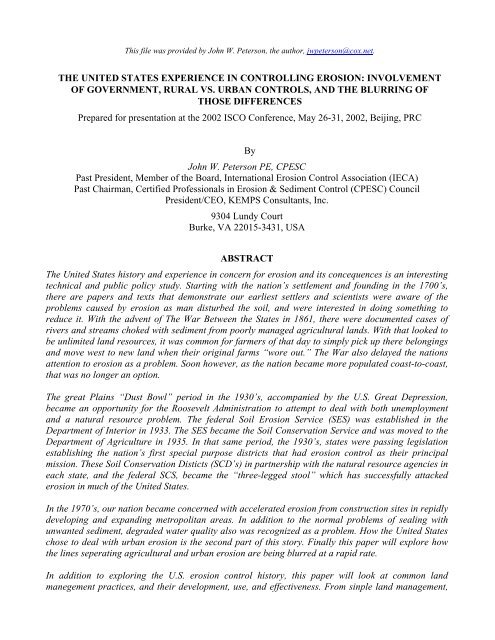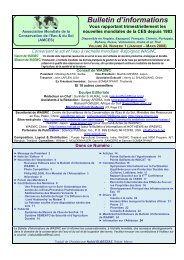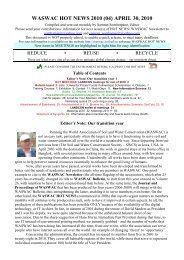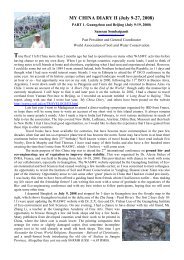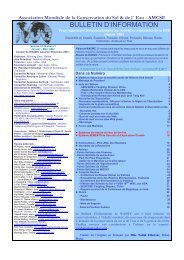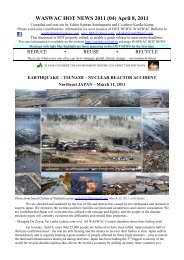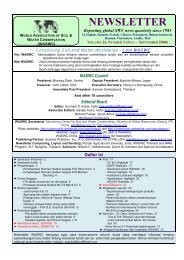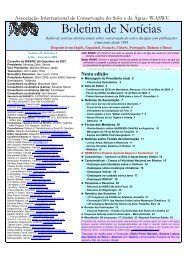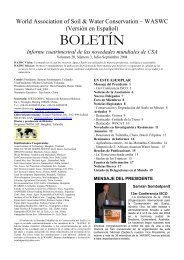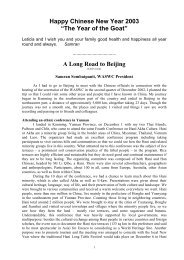B - World Association of Soil and Water Conservation
B - World Association of Soil and Water Conservation
B - World Association of Soil and Water Conservation
You also want an ePaper? Increase the reach of your titles
YUMPU automatically turns print PDFs into web optimized ePapers that Google loves.
The watershed as the logical unit for dealing with natural resource problems including erosion in theU.S., has long been recognized. The genesis <strong>of</strong> ideas about US watershed management or protection asit related to erosion, run<strong>of</strong>f, sedimentation, <strong>and</strong> a number <strong>of</strong> other environmental issues also goes backto the origins <strong>of</strong> the SCS. (12) We saw earlier how Hugh Hammond Bennett became convinced thatsoil erosion was a threat to future food productivity, <strong>and</strong> determined that he would work for a nationalprogram to correct the problem. When "Black Sunday" occurred on April 14th, 1935, Bennett's worktook on new meaning, <strong>and</strong> his efforts came into sharper focus. Bennett decided to concentrate onwatersheds near the US erosion experiment stations, where he might use the results <strong>of</strong> research. Thesignificant lesson is that from the beginning, the early US soil conservationists or erosion controlspecialists were concerned about the cumulative effects <strong>of</strong> erosion control on the entire watershed.FEDERAL ENCOURAGEMENT OF CONSERVATION DISTRICTSIt was mentioned earlier that the SCS was the federal governments first "erosion control" agency. One<strong>of</strong> the ways that SCS did its job, was to operate "erosion control demonstration projects." The federalgovernment, through the SCS, would buy, lease, or otherwise acquire control over considerable farmacreage on which soil erosion was a serious problem. Then, the SCS would develop a complete erosioncontrol plan for that acreage, <strong>and</strong> install that plan on the ground. Other farmers in the area wereencouraged to come to this demonstration project <strong>and</strong> learn how to install erosion control measures ontheir own farms. It was soon apparent to some key USDA <strong>of</strong>ficials, that as beneficial as thedemonstration projects were, the US would never be able to control erosion on millions <strong>of</strong> farms, in atthat time 48 states, out <strong>of</strong> Washington, DC. More local involvement <strong>and</strong> interest was needed. In aboutthe spring <strong>of</strong> 1935, Assistant Secretary <strong>of</strong> Agriculture M.L. Wilson assisted by Phillip M. Glick, starteddeveloping model legislation that could be <strong>of</strong>fered to the states for their consideration that wouldestablish state conservation or erosion control districts. These conservation districts were modeled after"conservancy districts", a local unit <strong>of</strong> state government like a county or a city, established by a statestatute, <strong>and</strong> responsible for water management activities. (14)In the US, the Federal Government does not have the authority to regulate private l<strong>and</strong> use. TheFederal Government does not have authority to establish local units <strong>of</strong> government. The states canestablish local units <strong>of</strong> government, but the Congress <strong>of</strong> the US cannot. Consequently, Wilson <strong>and</strong>Glick developed model conservation district legislation that they hoped states would adopt. Theconservation district would be the local "erosion control" unit <strong>of</strong> government, <strong>and</strong> could work inpartnership with state <strong>and</strong> federal agencies in addressing erosion control problems. The districts aresupervised by locally elected directors (occasionally there will be a mix <strong>of</strong> appointed <strong>and</strong> electeddirectors), <strong>and</strong> have broad authority to plan <strong>and</strong> execute erosion control projects. Over time, all thestates have adopted some form <strong>of</strong> conservation district legislation; consequently there are conservationdistricts in every state <strong>and</strong> territory. These conservation districts have become the focal point for ruralconservation activities, including water quality, <strong>and</strong> are particularly important at the urban-ruralinterface.FEDERAL URBAN EROSION CONTROLUS Environmental concerns were rooted in the vast social changes that took place after <strong>World</strong> War II.Although some beginnings can be identified in earlier years, only after the war did they become widelyshared social phenomena. (5) Evolving environmental values were closely associated with risingst<strong>and</strong>ards <strong>of</strong> living <strong>and</strong> levels <strong>of</strong> education. These changed markedly after the war. The US experiencedthe transition from an older stress on efficient development <strong>and</strong> use <strong>of</strong> natural resources such as soils,water <strong>and</strong> forests, known as the conservation movement, which took place in the first four decades <strong>of</strong>
the twentieth century. The transition was to an environmental movement. <strong>Conservation</strong> gave way toenvironment after <strong>World</strong> War II amid a rising interest in the quality <strong>of</strong> life beyond efficiency inproduction. The two tendencies <strong>of</strong>ten came into conflict as resources long thought <strong>of</strong> as important fortheir material commodities came to be prized for their aesthetic <strong>and</strong> amenity uses.Environmental affairs in US society stems from the circumstances <strong>of</strong> daily life, not from those shapedby technical specialization. People live <strong>and</strong> work in different places, <strong>and</strong> the character <strong>of</strong> those placesis attractive or degraded, healthful or dangerous, acceptable or unacceptable. What is defined asproblems arise from these settings <strong>and</strong> are solved or not in those environments <strong>of</strong> personal meaning.We can identify the city, the wild l<strong>and</strong>s, <strong>and</strong> the countryside as three distinct environments from whichdistinct ideas <strong>and</strong> actions flow. What the "environment" means to people in one setting, differsconsiderably from what it means in another.One <strong>of</strong> the most durable <strong>and</strong> pervasive issues <strong>of</strong> the American constitutional order is the distribution <strong>of</strong>powers geographically. The federal system affects nearly every policy issue in America, ranging fromissues such as national defense <strong>and</strong> medical care to the management <strong>of</strong> natural resources, including soil<strong>and</strong> water. (13) Despite the secular trend in the twentieth century toward an increasing role for thenational government in public policy generally <strong>and</strong> natural resource policy in particular, recentenactment's with respect to water pollution control <strong>and</strong> air pollution control clearly demonstrate thatresource policy will continue to be a shared responsibility between the national government <strong>and</strong> thestates. Undoubtedly, the national government <strong>and</strong> the states will continue to sort out theirresponsibilities through laws <strong>and</strong> litigation well into the future.The variability <strong>of</strong> the state responses to increased but shared responsibilities with respect to naturalresources policy is illustrated by the roles they have played with respect to controls <strong>of</strong> point (generallyconsidered an urban source) <strong>and</strong> non-point (generally considered agricultural or rural sources) sources<strong>of</strong> pollution. Non-point sources <strong>of</strong> pollution were generally divided into these five classes; nutrients,pesticides, salts, animal waste, <strong>and</strong> sediment. The federal presence is greatest regarding point sources<strong>of</strong> water pollution, with the US Environmental Protection Agency (EPA) specifying st<strong>and</strong>ards, means<strong>of</strong> achieving them, time tables, <strong>and</strong> compliance. With respect to nonpoint sources, the federal presenceis considerably less, setting attainment goals but leaving the method <strong>and</strong> procedures up to the states.Federal <strong>Water</strong> Pollution Control Act (Public Law 92-500)The Federal <strong>Water</strong> Pollution Control Act, also called the Clean <strong>Water</strong> Act, Public Law 92-500, wasenacted in 1972. (15) The objective <strong>of</strong> this act is to restore <strong>and</strong> maintain the chemical, physical, <strong>and</strong>biological integrity <strong>of</strong> the Nation's waters. The act considered both "point" <strong>and</strong> "non-point" sources<strong>of</strong> pollution. Concerning non point sources, which generally are considered as coming from the ruralareas, farms <strong>and</strong> ranches, etc., the act said.... "It is the national policy that programs for the control <strong>of</strong>non-point sources be developed <strong>and</strong> implemented in an expeditious manner so as to enable the goals<strong>of</strong> this act to be mew through the control <strong>of</strong> both point <strong>and</strong> nonpoint sources <strong>of</strong> pollution." The actwas much more descriptive in its treatment <strong>of</strong> point sources.Point sources are generally thought <strong>of</strong> as those that can be clearly shown as coming from a "point."In many cases that point is a pipe or culvert that drains waste from storm or sanitary sewers,commercial <strong>and</strong> industrial plants, etc. If that point source drains directly into a stream or other waterbody, <strong>and</strong> is contaminated, it can do tremendous harm to the water body. Rather than allowcontaminated waste to drain directly into water bodies, the act encouraged it be treated at treatmentplants. The act established the following policies. It declared it to be the national goal that discharge<strong>of</strong> pollutants into the navigable waters be eliminated by 1985. It also declared that it be the nationalpolicy that area-wide treatment management planning processes be developed <strong>and</strong> implemented to
assure adequate control <strong>of</strong> sources <strong>of</strong> pollutants in each state. It also established that a major research<strong>and</strong> demonstration effort be made to develop technology necessary to eliminate the discharge <strong>of</strong>pollutants into the navigable waters <strong>and</strong> the oceans.As the states <strong>and</strong> the federal government paid more attention to water quality, <strong>and</strong> as sedimentbecame identified as a "class" <strong>of</strong> pollutant, urban erosion control gained much more attention. Whilesediment by itself can do much damage by filling up reservoirs <strong>and</strong> ponds, silting up <strong>of</strong> navigation<strong>and</strong> other channels, damaging recreation areas, etc., the poisons that can attach to sediment is alsorecognized as a public health concern. (15) The Clean <strong>Water</strong> Act influenced many states to eitherstrengthen or pass for the first time, stormwater management <strong>and</strong> sediment control legislation. Thislegislation addresses other than rural sediment control, usually concentrating on housingdevelopments, highway construction, shopping centers, etc.STATE EROSION AND SEDIMENT CONTROL LEGISLATIONGenerally speaking, as the US states addressed sediment control legislation, they have tended toapproach it from two different perspectives. Some states are very "prescriptive" in the sense that theytell a developer quite specifically what they must do in a specific circumstance. Other states havechosen the path <strong>of</strong> being more "performance based", wherein they set the st<strong>and</strong>ards, <strong>and</strong> it is up tothe developer to meet them using methods <strong>of</strong> his/her choosing. We will take a look at two states'legislation, one <strong>of</strong> which might be considered "performance based" (North Carolina), <strong>and</strong> anotherthat is more "prescriptive," (Maryl<strong>and</strong>).North Carolina Sediment Pollution Control Act <strong>of</strong> 1973Many <strong>of</strong> the states sedimentation control acts cite objectives that are mirrored in the federal Clean<strong>Water</strong> Act. North Carolina's (Article 113A-51. Preamble) act says.... "The sedimentation <strong>of</strong> streams,lakes <strong>and</strong> other waters <strong>of</strong> this state constitute a major pollution problem. Sedimentation occurs fromthe erosion or depositing <strong>of</strong> soil <strong>and</strong> other materials into the waters, principally from constructionsites <strong>and</strong> road maintenance. The continued development <strong>of</strong> this State will result in an intensification<strong>of</strong> pollution through sedimentation unless timely <strong>and</strong> appropriate action is taken. Control <strong>of</strong> erosion<strong>and</strong> sedimentation is deemed vital to the public interest <strong>and</strong> necessary to the public health <strong>and</strong> welfare,<strong>and</strong> expenditures <strong>of</strong> funds for erosion <strong>and</strong> sediment control programs shall be deemed for a publicpurpose. It is the purpose <strong>of</strong> this Article to provide for the creation, administration, <strong>and</strong> enforcement <strong>of</strong>a program <strong>and</strong> for the adoption <strong>of</strong> minimal m<strong>and</strong>atory st<strong>and</strong>ards which will permit development <strong>of</strong> thisstate to continue with the least detrimental effects <strong>of</strong> pollution by sedimentation. In recognition <strong>of</strong> thedesirability <strong>of</strong> early coordination <strong>of</strong> sedimentation control planning, it is the desire <strong>of</strong> the GeneralAssembly that pre-construction conferences be held among the affected parties, subject to theavailability <strong>of</strong> staff." (17) The Act generally does not apply to agricultural <strong>and</strong> forestry l<strong>and</strong> disturbingactivities, <strong>and</strong> some mining activities, which are subject to other requirements.The North Carolina (NC) Act is under the jurisdiction <strong>of</strong> the NC Sedimentation Control Commission,acting through the NC Department <strong>of</strong> Environment, Health <strong>and</strong> Natural Resources, Division <strong>of</strong> L<strong>and</strong>Resources. The act sets out m<strong>and</strong>atory st<strong>and</strong>ards for l<strong>and</strong>-disturbing activities. An example is... "Nol<strong>and</strong>-disturbing activity during periods <strong>of</strong> construction or improvement to l<strong>and</strong> shall be permitted inproximity to a lake or natural watercourse unless a buffer zone is provided along the margin <strong>of</strong> thewater course <strong>of</strong> sufficient width to confine visible siltation within the 25% <strong>of</strong> the buffer zone nearestthe l<strong>and</strong>-disturbing activity." The Act also covers approval <strong>of</strong> erosion control plans, <strong>and</strong> how violationswill be h<strong>and</strong>led, including civil <strong>and</strong> criminal penalties in extreme cases.
It is worth mentioning, that NC's Division <strong>of</strong> L<strong>and</strong> Resources is a model <strong>of</strong> the state trying to workclosely with developers on projects, during the planning <strong>and</strong> implementation, to avoid problems inadvance. They do not sit around <strong>and</strong> wait for a problem to develop, <strong>and</strong> then deal with the violator.They are very proactive in this regard, <strong>and</strong> the state generally has a good rapport with developers. TheDivision <strong>of</strong> L<strong>and</strong> Resources has a very pr<strong>of</strong>essional, conscientious staff.Annotated Code <strong>of</strong> Maryl<strong>and</strong>, Environment, Subtitle 1, Sediment ControlMaryl<strong>and</strong>'s sediment control subtitle describes the reason for its existence much as other states do.Again, agricultural l<strong>and</strong> management activities are exempt. The Regulatory Agency is the Maryl<strong>and</strong>Department <strong>of</strong> the Environment, <strong>Water</strong> Management Administration. Their permit requirements say..."Any earth disturbance equal to or greater than 5,000 square feet (464.5 square meters) or involves 100cubic yards ( 76.5 cubic meters) requires the preparation <strong>and</strong> approval <strong>of</strong> a formal erosion <strong>and</strong>sediment control plan. In situations where 5 acres (2.1 hectares) <strong>of</strong> disturbance exists, a notice <strong>of</strong> intentis filed... ." (18)Typically a two phase plan is developed. Phase I controls are based upon existing contours, <strong>and</strong> isimplemented prior to any earth disturbance. Phase II utilizes controls on final/proposed contours.Usually those phases are designed on two separate sets <strong>of</strong> plans. The goal <strong>of</strong> the Maryl<strong>and</strong> program isto allow for infiltration <strong>of</strong> the first 1/2 inch (1.27 cm) <strong>of</strong> rain from all impervious surfaces <strong>and</strong> noincrease or preferably a decrease in the 25 year storm discharge rate. They also have penalties fornoncompliance, <strong>and</strong> can be as high as $50,000 US <strong>and</strong> up to two years in jail for repeat <strong>of</strong>fenders.Maryl<strong>and</strong> lists their preferred controls in descending order or preference, as:• Infiltration trenches• Earth Dikes/berms• Retention ponds• Extended retention ponds• Detention pondsMaryl<strong>and</strong>, like most states, also publishes st<strong>and</strong>ard <strong>and</strong> specifications for soil erosion <strong>and</strong> sedimentcontrol. (19) Maryl<strong>and</strong>'s st<strong>and</strong>ards <strong>and</strong> specifications address:• <strong>Water</strong> h<strong>and</strong>ling (dikes, diversions, etc.)• Grade stabilization structures• Sediment trapping devices• Dewatering practices• Filtering practices• L<strong>and</strong> grading <strong>and</strong> structural stabilization• Vegetative practices• Miscellaneous practices (dust control, straw bale dikes, silt fences, etc.)Mid-Atlantic IECA Chapter State Regulation SummaryThe Newly formed Mid- Atlantic Chapter <strong>of</strong> the International Erosion Control <strong>Association</strong> (Delaware,Maryl<strong>and</strong>, New Jersey, Pennsylvania, Virginia, <strong>and</strong> West Virginia) recently undertook a project tosummarize all the state sediment control legislation in their area <strong>of</strong> interest. That reference is includedas an attachment.
CONSIDERING EROSION AND SEDIMENT CONTROL AS A PROFESSIONThere are many reasons why the notion <strong>of</strong> specialists in erosion <strong>and</strong> sediment control should berecognized as pr<strong>of</strong>essionals. Today's complex use <strong>of</strong> our natural resources dem<strong>and</strong>s pr<strong>of</strong>essionals withmany skills. No single science, discipline or interest can claim exclusive expertise in erosion <strong>and</strong>sediment control. To be a fully competent practitioner, one must have some background in soils, plantscience, civil <strong>and</strong> agricultural engineering, geology, hydraulics <strong>and</strong> hydrology, environmental sciences,etc. Rarely does one posses all those skills without some training <strong>and</strong> experience gained by working inthe field with others. In the US, no college or university grants undergraduate degrees in erosion <strong>and</strong>sediment control. IECA is working with some major universities that could move in that direction. Inthe meantime, some states have already recognized the need for pr<strong>of</strong>essional recognition, <strong>and</strong> haveenacted state legislation to provide it. The IECA has been a co-sponsor <strong>of</strong> this program <strong>of</strong> CertifiedPr<strong>of</strong>essionals in Erosion <strong>and</strong> Sediment Control (CPESC's) since 1992.California Assembly Concurrent Resolution No. 31 (May 27, 1983)The California Resolution recommends to counties <strong>and</strong> cities that soil erosion <strong>and</strong> sediment controlspecialists certified as specified (the CPESC program) be consulted in the formulation <strong>and</strong>implementation <strong>of</strong> soil erosion <strong>and</strong> sediment issues in ordinances <strong>and</strong> plans. Each County Board <strong>of</strong>Supervisors <strong>and</strong> the City Council <strong>of</strong> each city in California was provided copies <strong>of</strong> the resolution, <strong>and</strong>many <strong>of</strong> them have passed their own legislation supporting pr<strong>of</strong>essional recognition.LOCAL EROSION AND SEDIMENT CONTROL LEGISLATIONMany subdivisions <strong>of</strong> state government, namely cities <strong>and</strong> counties, have also passed erosion <strong>and</strong>sediment legislation pertinent to their area <strong>of</strong> jurisdiction. Most <strong>of</strong> them were influenced by the federalor state legislation in existence. Examples are Shasta County California, Fairfax County, Virginia,Napa County, California, etc.Most <strong>of</strong> these county <strong>and</strong> city ordinances stress the need-to protect the public health <strong>and</strong> safety as thereason for concern with natural resource protection, <strong>and</strong> all refer to the problems associated withexcessive soil loss <strong>and</strong> its impact on water quality. Some <strong>of</strong> them also make reference to the need forCPESC's (County <strong>of</strong> Napa). Usually any county or city ordinance will make reference to statelegislation dealing with erosion or sediment control.LEGISLATIVE EFFECTS ON SOIL EROSIONQuestions arise frequently from the press, Congress, <strong>and</strong> the public about the results <strong>of</strong> the erosion <strong>and</strong>sediment control programs begun in the US in the 1930's. Essentially, the inquirers want to knowwhether the public funds expended on research, the technical assistance provided by various levels <strong>of</strong>government, <strong>and</strong> the financial assistance provided in the implementation <strong>of</strong> erosion control practices,have decreased erosion rates <strong>and</strong> otherwise led to environmental improvements.Only recently, within the last sixteen years, has the federal government through the USDA beensystematically collecting data that allows for comparisons <strong>of</strong> erosion rates over time. Most <strong>of</strong> theinformation relates to rural, agricultural erosion. Urban erosion caused by development, roadconstruction, etc., is less well documented. There may be project by project information available fromvarious jurisdictions.
3. Gregory G. Lebel <strong>and</strong> Hal Kane, Sustainable Development; A Guide to Our Common Future,Washington, DC, 1989.4. Arlington Herald, Virginia, Newspaper, April 6, 1995.5. Samuel P. Hays, "Beauty, Health <strong>and</strong> Permanence; Environmental Politics in the United States,"1955-1985, Cambridge University Press, 1987.6. Stuart Chase, "Rich L<strong>and</strong>, Poor L<strong>and</strong>," New York, 1936; Paul B. Sears, "Deserts on The March,"Norman, Oklahoma, 1936.7. U.S. Department <strong>of</strong> Agriculture, <strong>Soil</strong>s <strong>and</strong> Men, Washington, DC, 1938; Tom Dale <strong>and</strong> VernonCarter, Topsoil <strong>and</strong> Civilization, Norman, Oklahoma, 1955; Edward G. Cheney <strong>and</strong> Thorvald Schantz-Hansen, This is our l<strong>and</strong>, St. Paul, Minnesota, 1946.8. J. Douglas Helms, "Leadership Pr<strong>of</strong>iles <strong>of</strong> <strong>Conservation</strong> Pioneers", at National <strong>Association</strong> <strong>of</strong><strong>Conservation</strong> Districts Town Hall Meeting at the 50th Anniversary Annual Meeting, Las Vegas,Nevada, February 6, 1996.9. The <strong>Soil</strong> <strong>Conservation</strong> Act <strong>of</strong> 1935, Public Law 74-46, enacted April 27th, 1935.10. Public Law 70-769, 45 Stat. 1189, 1207, February 16th, 1929.11. The <strong>Water</strong>shed Protection <strong>and</strong> Flood Prevention Act, Public Law 83-566, 68 Stat. 666, August 4,1954.12. John W. Peterson, "The Place We're At: Setting the Stage," proceedings <strong>of</strong> the 4th National<strong>Water</strong>shed Conference, National <strong>Water</strong>shed Coalition, Charleston, West Virginia, May 22, 1995.13. Dean E. Mann, "Political Science: The Past <strong>and</strong> Future <strong>of</strong> <strong>Water</strong> Resources Policy <strong>and</strong>Management," in <strong>Water</strong> Resources Administration in the United States, Michigan State UniversityPress, East Lansing, Michigan, 1993.14. J. Douglas Helms, "The Preparation <strong>of</strong> the St<strong>and</strong>ard State <strong>Soil</strong> <strong>Conservation</strong> Districts Law; AnInterview with Phillip M. Glick," US Department <strong>of</strong> Agriculture, Washington, DC, February 1990.15. Public Law 92-500, 33 U.S.C. 1251 et seq., 1972.16. John W. Peterson, "Erosion/Sediment Control is a Pr<strong>of</strong>ession," Journal o f <strong>Soil</strong> <strong>and</strong> <strong>Water</strong><strong>Conservation</strong>, <strong>Soil</strong> <strong>and</strong> <strong>Water</strong> <strong>Conservation</strong> Society, Ankeny, IA, March-April, 1993, 102.17. North Carolina Sedimentation Pollution Control Act <strong>of</strong> 1973.18. Annotated Code <strong>of</strong> Maryl<strong>and</strong>, Subtitle 1. Sediment Control, Title 4-101.19. "1994 Maryl<strong>and</strong> St<strong>and</strong>ards <strong>and</strong> Specifications for Erosion <strong>and</strong> Sediment Control," Maryl<strong>and</strong>Department <strong>of</strong> the Environment, 1994.20. California Assembly Concurrent Resolution No. 31, Resolution Chapter 36, filed with the Secretary<strong>of</strong> State, may 27th, 1983.21. "Historical Changes in <strong>Soil</strong> Erosion, 1930-1992, The Northern Mississippi Valley Loess Hills," USDepartment <strong>of</strong> Agriculture, Washington, DC, June 1995.22. T. Tanner, Editor, “Aldo Leopold, the Man <strong>and</strong> His Legacy," <strong>Soil</strong> <strong>and</strong> <strong>Water</strong> <strong>Conservation</strong> Society,Ankeny, Iowa, 1987.


